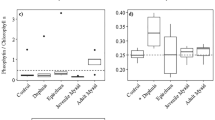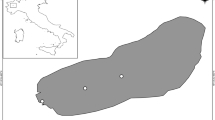Abstract
A simple heuristic theory based on conservation of matter and describing the fate of autotrophic production in pelagic ecosystems was developed to assist in conceptualizing how zooplankton affect sedimentation processes in lakes and oceans. The theory predicted that effects of zooplankton on the fraction of autotrophic incorporation that sediments (the “export ratio”) will be a function of factors related both to zooplankton digestion and egestion and to tendencies of particulate matter to sediment directly prior to mineralization. As a result, effects of zooplankton grazing on the export ratio were predicted to be site-dependent, a function of physical conditions and zooplankton communities characterizing an ecosystem. The theory was tested by monitoring autotrophic production of C, N, and P, sedimentation of C, N, and P, and zooplankton biomass in two lakes of the Canadian shield characterized by contrasting morphometry and food-web structure. In Lake 110, a small elongate lake protected from wind exposure, export ratios of C, N, and P declined strongly with zooplankton biomass. In contrast, in L240, a larger lake with considerably greater wind exposure, export ratios increased with zooplankton biomass. These results were consistent with predictions of our theory that effects of zooplankton on sedimentation processes will depend on the tendency of particulate matter to directly sediment relative to the tendency of egested materials to sediment. However, no significant differences in relationships between export ratios for C, N, and P and zooplankton biomass were found.
Similar content being viewed by others
References
Aksnes DL & Wassman P (1993) Modeling the significance of zooplankton grazing for export production. Limnol. Oceanogr. 38: 978–985
Alldredge AL & Silver MW (1988) Characteristics, dynamics, and significance of marine snow. Progr. Oceanogr. 20: 41–82
Alldredge AL, Gotschalk CC & MacIntyre S (1987) Evidence for the sustained residence of macrocrustacean fecal pellets in surface waters off Southern California. Deep-Sea Res. 34: 1641–1652
American Public Health Association (1992) Standard Methods for the Examination of Water and Wastewater. 18th ed. Washington, DC
Andersen T & Hessen DO (1991) Carbon, nitrogen, and phosphorus content of freshwater zooplankton. Limnol. Oceanogr. 36: 807–814
Angel MV (1984) Detrital organic fluxes through pelagic ecosystems. In: Fasham MJR (Ed) Flows of Energy and Materials in Marine Ecosystems (pp 475–516). Plenum, New York
Angel MV (1989) Does mesopelagic biology affect the vertical flux? In: Berger WH, Smetacek VS & Wefer G (Eds) Productivity of the Ocean: Present and Past (pp 155–173). John Wiley & Sons, New York
Baines SB & Pace ML (1994) Relationships between suspended particulate matter and sinking flux along a trophic gradient and implications for the fate of planktonic primary production. Can. J. Fish. Aquat. Sci. 51: 25–36
Bishop JKB (1989) Regional extremes in particulate matter composition and flux: effects on the chemistry of the ocean interior. In: Berger WH, Smetacek VS & Wefer G (Eds) Productivity of the Ocean: Present and Past (pp 117–137). John Wiley & Sons, New York
Bloesch J & Burgi HR (1989) Changes in phytoplankton and zooplankton biomass and composition reflected by sedimentation. Limnol. Oceanogr. 34: 1048–1062
Bloesch J & Burns NM (1980) A critical review of sedimentation trap technique. Schweiz. Z. Hydrol. 42: 15–45
Capblancq J (1990) Nutrient dynamics and pelagic food web interactions in oligotrophic and eutrophic environments: an overview. Hydrobiologia 207: 1–14
Carpenter SR, Kitchell JF & Hodgson JR (1985) Cascading trophic interactions and lake productivity. Bioscience 35: 634–639
Chrzanowski TH, Stemer RW & Elser JJ (1995) Nutrient enrichment and nutrient regeneration stimulate bacterioplankton growth. Microb. Ecol. 29: 221–230
DeMott WR (1989) The role of competition in zooplankton succession. In: Sommer U (Ed) Plankton Ecology: Succession in Plankton Communities (pp 195–252). Springer-Verlag, Berlin
Elser JJ, Chrzanowski TH, Sterner RW, Schampel JH & Foster DK (1995) Elemental ratios and the uptake and release of nutrients by phytoplankton and bacteria in three lakes of the Canadian Shield. Microb. Ecol. 29: 145–162
Eppley RW & Petersen PJ (1979) Particulate organic matter flux and planktonic new production in the deep ocean. Nature 282: 677–680
Fee EJ (1990) Computer programs for calculating in situ phytoplankton photosynthesis. Can. Tech. Rep. Fish. Aquat. Sci. 1740: v + p
Fee EJ & Hecky RE (1992) Introduction to the Northwest Ontario Lake Size Series (NOLSS). Can. J. Fish. Aquat. Sci. 49: 2434–2444
Fee EJ, Hecky RE, Regehr GW, Hendzel LL & Wilkinson P (1994) Effects of lake size on nutrient availability in the mixed layer during summer stratification. Can. J. Fish. Aquat. Sci.: in press
Ferrante JC & Parker JI (1977) The influence of planktonic and benthic crustaceans on silicon cycling in Lake Michigan, USA. Verh. Internat. Verein. Limnol. 20: 324–328
Findlay DL, Hecky RE & Regehr GW (1994) Relationship between N2-fixation and heterocyst abundance and its relevance to the nitrogen budget of Lake 227. Can. J. Fish. Aquat. Sci. 51: 2254–2266
Fowler SW & Knauer GA (1986) Role of large particles in the transport of elements and organic compounds through the oceanic water column. Prog. Oceanogr. 16: 147–194
Harris GP (1986) Phytoplankton Ecology: Structure, Function, and Fluctuation. Chapman and Hall, London
Hecky RE, Campell P & Hendzel LL (1993) The stoichiometry of carbon, nitrogen, and phosphorus in particulate matter of lakes and oceans. Limnol. Oceanogr. 38: 709–724
Honjo S & Roman MR (1978) Marine copepod fecal pellets: production, preservation and sedimentation. J. Mar. Res. 36: 45–57
Knauer GA, Martin JH & Bruland KW (1979) Fluxes of particulate carbon, nitrogen, and phosphorus in the upper water column of the northeast Pacific. Deep-Sea Res. 26A: 97–108
Lampitt RS, Noji T & von Bodungen B (1990) What happens to zooplankton faecal pellets? Implications for material flux. Mar. Biol. 104: 15–23
Legendre L & Le Fèvre J (1989) Hydrodynamical singularities as controls of recycled versus export production in oceans. In: Berger WH, Smetacek VS & Wefer G (Eds) Productivity of the Ocean: Present and Past (pp 49–63). John Wiley & Sons, New York
Likens GE & Davis MB (1975) Post-glacial history of Mirror Lake and its watershed in New Hampshire, USA: an initial report. Int. Ver. Theor. Angew. Limnol. Verh. 19: 982–993
Mazumder A, Taylor WD, McQueen DJ & Lean DRS (1989) Effects of fertilization and planktivorous fish on epilimnetic phosphorus and phosphorus sedimentation in large enclosures. Can. J. Fish. Aquat. Sci. 46: 1735–1742
Pace ML, Knauer GA, Karl DM & Martin JH (1987) Primary production, new production, and vertical flux in the eastern Pacific Ocean. Nature 325: 803–804
Paffenhöfer GA & Knowles SC (1979) Ecological implications of fecal pellet size, production and consumption by copepods. J. Mar. Res. 37: 35–49
Paffenhöfer GA & Strickland JDH (1970) A note on the feeding ofCalanus helgolandicus on detritus. Mar. Biol. 5: 97–99
Parsons TR, Takahashi M & Hargrave B (1977) Biological Oceanographic Processes. Pergamon Press, Oxford
Peinert R, von Bodungen B & Smetacek VS (1989) Food web structure and loss rate. In: Berger WH, Smetacek VS & Wefer G (Eds) Productivity of the Ocean: Present and Past (pp 35–48). John Wiley & Sons, New York
Peterson BJ (1978) Radiocarbon uptake: its relation to net particulate carbon production. Limnol. Oceanogr. 23: 179–184
Reynolds CS (1984) The Ecology of Freshwater Phytoplankton. Cambridge University Press, Cambridge
Samelle O (1992) Contrasting effects ofDaphnia on ratios of nitrogen to phosphorus in a eutrophic, hard-water lake. Limnol. Oceanogr. 37: 1527–1542
Schoenberg SA & Carlson RE (1984) Direct and indirect effects of zooplankton grazing on phytoplankton in a hypereutrophic lake. Oikos 42: 291–302
Silver MW & Gowing MM (1991) The “particle” flux: origins and biological components. Prog. Oceanogr. 26: 75–113
Smayda TJ (1970) The suspension and sinking of phytoplankton in the sea. Ann. Rev. Oceanogr. Mar. Biol. 8: 353–414
Smetacek VS (1984) The supply of food to the benthos. In: Fasham MJR (Ed) Flows of Energy and Materials in Marine Ecosystems (pp 517–548). Plenum, New York
Sterner RW (1989) The role of grazers in phytoplankton succession. In: Sommer U (Ed) Plankton Ecology: Succession in Plankton Communities (pp 107–170). Springer-Verlag, Berlin
Sterner RW, Elser JJ & Hessen DO (1992) Stoichiometric relationships among producers, consumers, and nutrient cycling in pelagic ecosystems. Biogeochemistry 17: 49–67
Suess E (1980) Particulate organic carbon flux in the oceans-surface productivity and oxygen utilization. Nature 288: 260–263
Uehlinger U & Bloesch J (1987a) Variation in the C : P ratio of suspended and settling seston and its significance for P uptake calculations. Freshwater Biol. 17: 99–108
Uehlinger U & Bloesch J (1987b) The influence of crustacean zooplankton on the size structure of algal biomass and suspended and settling seston (Biomanipulation in limnocorrals 2). Int. Rev. Gesamten Hydrobiol. 72: 473–486
Valiela I (1991) Ecology of water columns. In: Barnes RSK & Mann KH (Eds) Fundamentals of Aquatic Ecology (pp 29–56). Blackwell Scientific Publications, Oxford
Walsh JJ, Rowe GT, Iverson RL & McRoy CP (1981) Biological export of shelf carbon is a neglected sink of the global CO2 cycle. Nature 291: 196–201
Williams PJ leB & von Bodungen B (1989) Export productivity from the photic zone. In: Berger WH, Smetacek VS & Wefer G (Eds) Productivity of the Ocean: Present and Past (pp 99–115). John Wiley & Sons, New York
Author information
Authors and Affiliations
Rights and permissions
About this article
Cite this article
Elser, J.J., Foster, D.K. & Hecky, R.E. Effects of zooplankton on sedimentation in pelagic ecosystems: Theory and test in two lakes of the Canadian shield. Biogeochemistry 30, 143–170 (1995). https://doi.org/10.1007/BF02186411
Received:
Accepted:
Issue Date:
DOI: https://doi.org/10.1007/BF02186411




